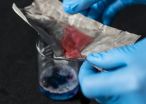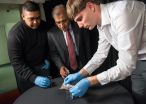(Press-News.org) COLUMBUS, Ohio--The unassuming piece of stainless steel mesh in a lab at The Ohio State University doesn't look like a very big deal, but it could make a big difference for future environmental cleanups.
Water passes through the mesh but oil doesn't, thanks to a nearly invisible oil-repelling coating on its surface.
In tests, researchers mixed water with oil and poured the mixture onto the mesh. The water filtered through the mesh to land in a beaker below. The oil collected on top of the mesh, and rolled off easily into a separate beaker when the mesh was tilted.
The mesh coating is among a suite of nature-inspired nanotechnologies under development at Ohio State and described in two papers in the journal Nature Scientific Reports. Potential applications range from cleaning oil spills to tracking oil deposits underground.
"If you scale this up, you could potentially catch an oil spill with a net," said Bharat Bhushan, Ohio Eminent Scholar and Howard D. Winbigler Professor of mechanical engineering at Ohio State.
The work was partly inspired by lotus leaves, whose bumpy surfaces naturally repel water but not oil. To create a coating that did the opposite, Bhushan and postdoctoral researcher Philip Brown chose to cover a bumpy surface with a polymer embedded with molecules of surfactant--the stuff that gives cleaning power to soap and detergent.
They sprayed a fine dusting of silica nanoparticles onto the stainless steel mesh to create a randomly bumpy surface and layered the polymer and surfactant on top.
The silica, surfactant, polymer, and stainless steel are all non-toxic and relatively inexpensive, said Brown. He estimated that a larger mesh net could be created for less than a dollar per square foot.
Because the coating is only a few hundred nanometers (billionths of a meter) thick, it is mostly undetectable. To the touch, the coated mesh doesn't feel any bumpier than uncoated mesh. The coated mesh is a little less shiny, though, because the coating is only 70 percent transparent.
The researchers chose silica in part because it is an ingredient in glass, and they wanted to explore this technology's potential for creating smudge-free glass coatings. At 70 percent transparency, the coating could work for certain automotive glass applications, such as mirrors, but not most windows or smartphone surfaces.
"Our goal is to reach a transparency in the 90-percent range," Bhushan said. "In all our coatings, different combinations of ingredients in the layers yield different properties. The trick is to select the right layers."
He explained that certain combinations of layers yield nanoparticles that bind to oil instead of repelling it. Such particles could be used to detect oil underground or aid removal in the case of oil spills.
The shape of the nanostructures plays a role, as well. In another project, research assistant Dave Maharaj is investigating what happens when a surface is made of nanotubes. Rather than silica, he experiments with molybdenum disulfide nanotubes, which mix well with oil. The nanotubes are approximately a thousand times smaller than a human hair.
Maharaj measured the friction on the surface of the nanotubes, and compressed them to test how they would hold up under pressure.
"There are natural defects in the structure of the nanotubes," he said. "And under high loads, the defects cause the layers of the tubes to peel apart and create a slippery surface, which greatly reduces friction."
Bhushan envisions that the molybdenum compound's compatibility with oil, coupled with its ability to reduce friction, would make it a good additive for liquid lubricants. In addition, for micro- and nanoscale devices, commercial oils may be too sticky to allow for their efficient operation. Here, he suspects that the molybdenum nanotubes alone could be used to reduce friction.
This work began more than 10 years ago, when Bhushan began building and patenting nano-structured coatings that mimic the texture of the lotus leaf. From there, he and his team have worked to amplify the effect and tailor it for different situations.
"We've studied so many natural surfaces, from leaves to butterfly wings and shark skin, to understand how nature solves certain problems," Bhushan said. "Now we want to go beyond what nature does, in order to solve new problems."
"Nature reaches a limit of what it can do," agreed Brown. "To repel synthetic materials like oils, we need to bring in another level of chemistry that nature doesn't have access to."
INFORMATION:
This work was partly funded by the American Chemical Society Petroleum Research Fund, the National Science Foundation, and Dexerials Corporation (formerly a chemical division of Sony Corp.) in Japan.
Contact: Bharat Bhushan, (614) 292-0651; Bhushan.2@osu.edu
Written by Pam Frost Gorder, (614) 292-9475; Gorder.1@osu.edu
http://www.nature.com/srep/2015/150303/srep08701/full/srep08701.html
http://www.nature.com/srep/2015/150223/srep08539/full/srep08539.html END
The sound, light and temperature levels in paediatric hospital wards often vary, highlighting the lack of consistent environmental standards, according to a new study.
The research is being presented today at the 2015 Sleep and Breathing Conference (16 April, 2015).
Children and parents often suffer sleep deprivation when the environment on a ward is disruptive, which can affect disease recovery and quality of life in hospitalised children. There are no general consistent recommendations covering sound, light and temperature levels to help guide hospitals across ...
Sleep disordered breathing can hamper memory processes in children, according to a new study.
The research, which will be presented today at the Sleep and Breathing Conference (16 April 2015), found that disrupted sleep had an impact on different memory processes and how children learn.
Eszter Csabi led a team of researchers from the University of Szeged and Eötvös Loránd University in Hungary. They analysed 17 children with sleep disordered breathing aged between 6 and 12 years. They looked at different memory processes compared to a control group ...
Imagine having your MRI results sent directly to your phone, with no concern over the security of your private health data. Or knowing your financial information was safe on a server halfway around the world. Or sending highly sensitive business correspondence, without worrying that it would fall into the wrong hands.
Thanks to new research from engineers at the University of Toronto, these types of perfectly secure information exchanges are one step closer to reality. Published this week in Nature Communications, researchers have designed the first all-photonic quantum ...
Children with intellectual disabilities--significantly low cognitive functioning coupled with significant deficits in adaptive or everyday functioning--make up 2 to 3 percent of the population, and it's estimated that 1 in 3 children with disabilities experiences some form of maltreatment. However, in many cases, the disclosures of children with intellectual disabilities aren't investigated or taken to court, in part because of concern over whether these children can describe their experiences sufficiently and be believed by juries. A new study has found that children with ...
Eleven percent of all births worldwide are preterm, or occurring before 37 weeks of pregnancy, and preterm-related causes of death account for a significant number of infant deaths, as well as long-term neurological disabilities. Efforts are under way, including an initiative by the Eunice Kennedy Shriver National Institute of Child Health and Human Development, to reduce elective deliveries before 39 weeks of pregnancy. Now two new longitudinal studies that appear in the journal Child Development offer insights on how to decrease the problems associated with premature ...
Preschoolers and school-age children who are good at identifying what others want, think, and feel are more popular in school than their peers who aren't as socially adept. That's the conclusion of a new meta-analysis--a type of study that looks at the results of many different studies--out of Australia.
The study was done at the University of Queensland, Australia, and appears in the journal Child Development.
"Our study suggests that understanding others' mental perspectives may facilitate the kind of interactions that help children become or remain popular," notes ...
Adolescence is a time of frequent and intense emotional experiences, but some youth handle their emotions better than others. Why do some young people react adaptively while others ruminate? A new study of adolescents shows that youth who mentally take a step back from their own point of view when thinking about something troubling can deal with negative emotions more effectively and become less upset by them.
The study, conducted by researchers at the University of Pennsylvania and the University of Michigan, appears in the journal Child Development.
The researchers ...
In a small study, Johns Hopkins researchers found that DNA from the sperm of men whose children had early signs of autism shows distinct patterns of regulatory tags that could contribute to the condition. A detailed report of their findings will be published online in the International Journal of Epidemiology on April 15.
Autism spectrum disorder (autism) affects one in 68 children in the U.S. Although studies have identified some culprit genes, most cases remain unexplained. But most experts agree that autism is usually inherited, since the condition tends to run in ...
Cincinnati, OH, April 15, 2015 -- Children with autism spectrum disorder (ASD) can develop symptoms before 2 years of age and usually can be diagnosed by 3 years of age; early identification of ASD is associated with improved long-term developmental outcomes. In a new study scheduled for publication in The Journal of Pediatrics, researchers assessed how healthcare providers respond to parents' concerns about their child's early development, as well as how that response affected the timeliness of ASD diagnosis.
Katharine Zuckerman, MD, MPH, and colleagues from Doernbecher ...
3D printing has been used to make everything from cars to medical implants. Now, ecologists are using the technology to make artificial flowers, which they say could revolutionise our understanding of plant-pollinator interactions. Their study involving hawkmoths - a close relative of the species made famous by the film Silence of the Lambs - is published in the British Ecological Society's journal Functional Ecology.
Since long before Charles Darwin, ecologists have been fascinated by flower shape, and in particular how animal pollinators have shaped the evolution of ...


